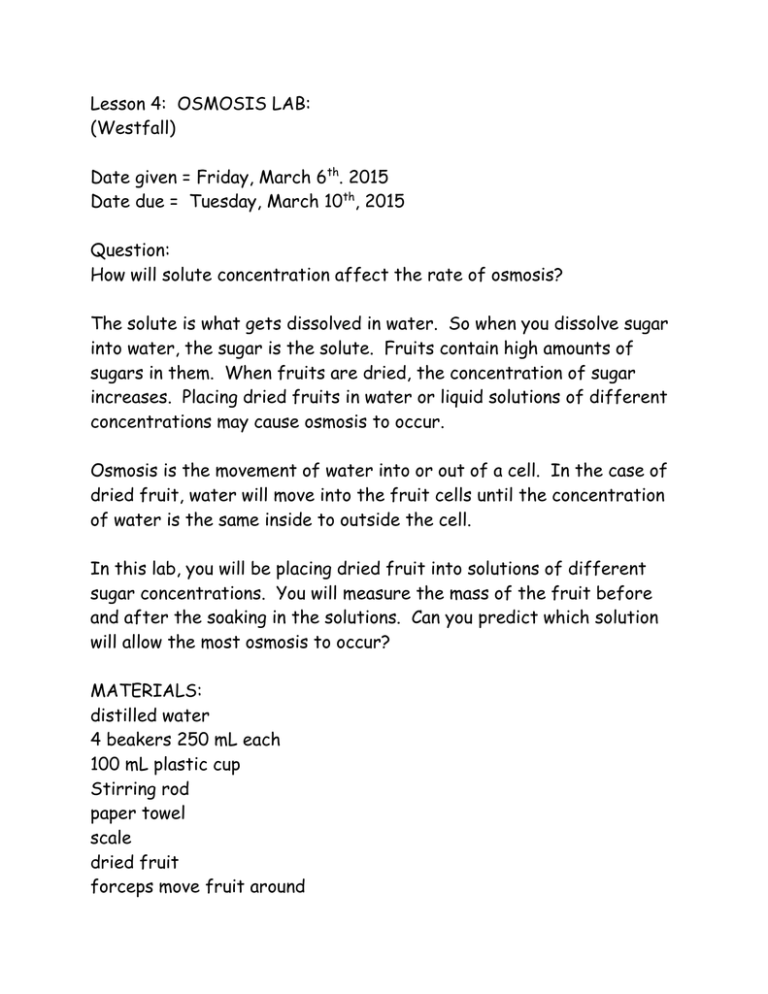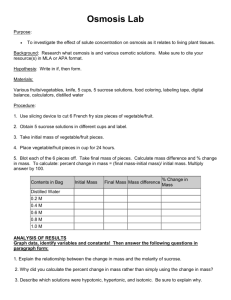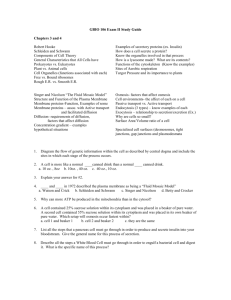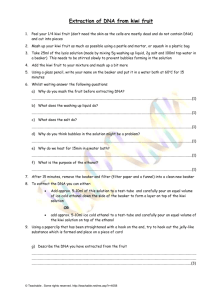Lesson 4 Osmosis fruit lab 2015
advertisement

Lesson 4: OSMOSIS LAB: (Westfall) Date given = Friday, March 6th. 2015 Date due = Tuesday, March 10th, 2015 Question: How will solute concentration affect the rate of osmosis? The solute is what gets dissolved in water. So when you dissolve sugar into water, the sugar is the solute. Fruits contain high amounts of sugars in them. When fruits are dried, the concentration of sugar increases. Placing dried fruits in water or liquid solutions of different concentrations may cause osmosis to occur. Osmosis is the movement of water into or out of a cell. In the case of dried fruit, water will move into the fruit cells until the concentration of water is the same inside to outside the cell. In this lab, you will be placing dried fruit into solutions of different sugar concentrations. You will measure the mass of the fruit before and after the soaking in the solutions. Can you predict which solution will allow the most osmosis to occur? MATERIALS: distilled water 4 beakers 250 mL each 100 mL plastic cup Stirring rod paper towel scale dried fruit forceps move fruit around METHOD: 1. Label 4 beakers as beaker #1, #2, #3, #4. 2. Using the 100 mL plastic measuring cup, pour water into it until it is full. Pour this into beaker #1. 3. Repeat step 2 for all beakers. 4. Turn on the scale. 5. Place a piece of paper towel on it. Tare the scale to zero to make sure the weight of the paper is not included in the weight of the sugar. 6. Using a scoopula, measure 5 grams of sugar and place this into beaker #2. Stir with the stirring rod. 7. Using a scoopula, measure 20 grams of sugar and place this into beaker #3. Stir with the stirring rod. 8. Using a scoopula, measure 40 grams of sugar and place this into beaker #4. Stir with the stirring rod. 9. Obtain 10 pieces of dried fruit from your teacher and place them on a piece of paper towel. From now on, fruit will NOT be touched by your hands to prevent moisture from moving from your hands into the fruit. 10.. Using forceps and a scale, measure the dry weight of the fruit. Record this in your observations. 11.. Place this fruit into beaker #1. 12.. Repeat steps 10 and 11 for beaker 2,3, and 4. 13.. Leave the fruit in the beaker overnight. 14.. Using forceps, place the fruit from beaker #1 on some paper towel. Pat the fruit lightly to take off excess moisture. 15.. Turn on the scale. Place a small piece of paper towel on it. Tare it to zero. (This makes it so that the paper towel is NOT included in the weight.) 16.. Using forceps, put the fruit on the paper towel. Record the weight of fruit #1 in your observations. 17.. Repeat steps #14-16 for all the beakers. 18. Discard the solutions down the drain. Fruit can be thrown out into a garbage pail. 19.. Wash all beakers with soap and water. 20. Wash your hands with soap and water. Clean up your area. OBSERVATIONS: You are asked to make a table of information for this lab. The table will have 4 columns and 5 rows in it. The titles of each are below. Column 1 = sucrose concentration. Column 2 = mass before. Column 3 = mass after. Column 4 = % mass change. Row 1 = the titles mentioned above. Row 2 = 0 % Row 3 = 5 % Row 4 = 20 % Row 5 = 40 % Remember to put a title for the whole table above the table to describe what the table is about. INTERPRETATIONS: 1. Calculate the percentage mass change for each sucrose solution according to the following equation: % mass change = ((mass after minus mass before) divided by mass before ) times 100 % 2. Which % sucrose solution had the greatest increase in mass? Explain why. 3. Which % sucrose solution had the least increase in mass? Explain why. 4. What are five ‘controlled variables’ used in this lab? These are things that you kept the same from beaker to beaker. 5. What is the ‘independent variable’ in this lab? This is what you are testing in this lab. What are you changing from one beaker to the other? 6. What is the ‘dependent variable’ in this lab? This is what you are measuring in this lab. 7. ‘Experimental error’ is mistakes that are done during a lab unintentionally. They just happen as you do the lab. These mistakes will often change the results of a lab. That is why is it good to repeat a lab several times to make sure you are doing it well and getting accurate results. Suggest three examples of experimental error in this lab. CONCLUSION: Which concentration of sucrose had the most osmosis occurring in this lab? Explain why.



